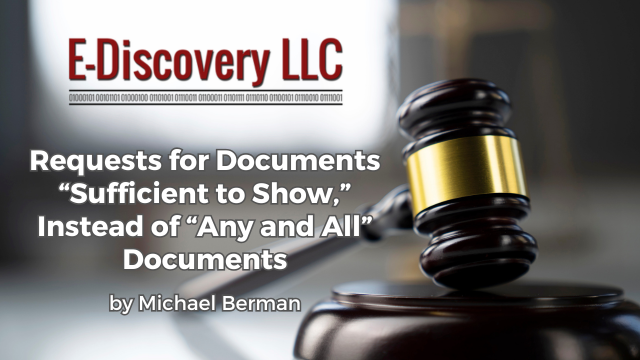
[EDRM Editor’s Note: This article was first published here on June 30, 2025. The opinions and positions are those of Michael Berman.]
In The Loan Source Inc. v. Newity LLC, 2025 WL 1755230 (D. Del. Jun. 25, 2025), plaintiffs’ request for production number 19 sought documents “sufficient to show Defendants’ efforts to settle a lawsuit….” Their motion to compel was granted over relevance and other objections. The court wrote: “Thus, Defendants must produce documents sufficient to show their efforts to settle the ExWorks litigation….” [Emphasis added].
Thus, Defendants must produce documents sufficient to show their efforts to settle the ExWorks litigation….
The Loan Source Inc. v. Newity LLC, 2025 WL 1755230 (D. Del. Jun. 25, 2025) (emphasis added).
Similarly, RFP 26 was drafted as a request for documents “sufficient to show” another factual issue. A motion to compel was also granted: “Thus, Defendant Newity must produce materials sufficient to show its relationship with NEB.”
“Sufficient to show” requests are an example of what is called the “bull’s eye view” of focused discovery requests. See S. Gensler, “Bull’s-Eye View of Cooperation in Discovery,” 10 Sedona Conf. L.J. 363 (2009); New Sedona Primer Implements the “Bull’s Eye View” of Discovery Requests (Dec. 8, 2021).
Requests for documents “sufficient to show” a relevant fact seem more common. For example, one litigant requested: “Documents sufficient to show Your liabilities from 2013 to the present on a monthly basis.” Megatel Homes III, LLC v. Moayedi, 2025 WL 1638927, at *8 (N.D. Tex. June 9, 2025); Bacarella v. Prime Hydration, LLC, 2025 WL 1615136, at *1 (S.D. Fla. June 6, 2025) (requesting “[d]ocuments sufficient to show the valuation of each of the Asserted Marks”).
However, “sufficient to show” is not a magic term. Requests still must seek documents within the scope of discovery that are proportional to the needs of the case. Ardagh Metal Packaging USA Corp. v. Am. Craft Brewery, LLC, 2025 WL 1640311, at *2 (N.D. Ill. June 10, 2025); E.D.Q.C. v. Warden, Stewart Det. Ctr., 2025 WL 1575609, at *6 (M.D. Ga. June 3, 2025).
When appropriate, “sufficient to show” requests have been beneficial. Timeliness, Showing of Incomplete Production, and “Sufficient to Show” Discovery Requests (Jan. 3, 2025)(citing IBM’s use of the drafting technique); Keyword Hits + Overbroad Terms ≠ Duty to Produce (Sep. 9, 2024).
In its “Primer on Crafting eDiscovery Requests with ‘Reasonable Particularity,’” 23 Sedona Conf. J. 331, 372-75 (2022), the Sedona Conference suggested using “sufficient to show” to replace “any and all” requests, where appropriate. The Sedona Primer provides detailed examples of where they may, or may not be, appropriate.
Requests for “any and all” documents have long been criticized. Requests for “Any and All” Documents Are Obsolete – Update (Jul. 6, 2024); Requests for “Any and All” Documents Are Obsolete (Feb. 4, 2021).
One alternative is that used in The Loan Source. For example, in Maker’s Mark Distiller, Inc. v. Spalding Grp., Inc., 2021 WL 2018880 at *8 (W.D. Ky. Apr. 20, 2021), a party requested “[d]ocuments sufficient to disclose” annual revenue.
Another suggestion is that: “Limitation of the inquiry to ‘material’ and ‘principal’ facts, as opposed to ‘all’ facts makes the interrogatory acceptable in form.” The Hon. Paul W. Grimm (ret.), Charles Fax, and Paul Sandler, “Maryland Discovery Problems and Solutions” (Md. State Bar Ass’n. 2020), 59.
There is, of course, no silver bullet and no magic words. One of my colleagues, Alicia L. Shelton, Esq., has suggested that narrowly-tailored “any and all” requests may be appropriate. The Sedona Primer agrees:
“Any and all” requests may also be appropriate when the requests seek only a limited, knowable number of the documents. In a slip-and-fall case, a party may request all surveillance footage of the incident. The key is to use “any and all” requests sparingly and appropriately.
23 Sedona Conf. J. at 375.
The Sedona Primer states:
“Any and all” requests may still be appropriate for documents that go to the heart of the claims or defenses and for which the full breadth of responsive materials may itself be instructive.
Id.
To paraphrase The Hon. Paul W. Grimm, a “court may look for guidance to the many reported decisions on this issue. However, when it does so, it will quickly discover that, as at ‘Alice’s Restaurant,’ one can find what one wants.” Sullivan v. Glock, Inc., 175 F.R.D. 497, 505 (D. Md. 1997).
Read the original article here.
Assisted by GAI and LLM Technologies per EDRM GAI and LLM Policy.


